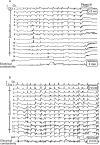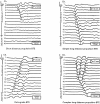Abnormal postprandial duodenal chyme transport in patients with long standing insulin dependent diabetes mellitus
- PMID: 9414968
- PMCID: PMC1891578
- DOI: 10.1136/gut.41.5.624
Abnormal postprandial duodenal chyme transport in patients with long standing insulin dependent diabetes mellitus
Abstract
Background: Patients with long standing diabetes mellitus frequently have upper gut dysmotility. Gastroparesis has been well studied, whereas detailed data on duodenal motor function are limited.
Aims: To characterise postprandial duodenal chyme transport in such patients.
Methods: Intraluminal multiple impedance measurement, recently introduced as a novel technique for investigation of chyme transport, was used to study postprandial duodenal chyme flow in 10 patients with long standing insulin dependent diabetes mellitus with gastroparesis, and 10 healthy volunteers.
Results: Four distinct transport patterns of chyme, termed bolus transport events (BTEs), were found in both groups and could be characterised as: short distance propulsive; simple long distance propulsive; retrograde; and complex long distance propulsive. Diabetic patients had significantly lower numbers of propulsive BTEs (p < 0.01), and higher proportions of retrograde BTEs and complex long distance BTEs (p < 0.05) than control subjects, whereas the proportion of simple long distance BTEs was significantly lower (p < 0.05). The mean propagation velocities of the BTEs were similar in both groups.
Conclusion: Abnormal postprandial duodenal chyme transport was found in patients with long standing insulin dependent diabetes mellitus. This is characterised by transport disorganisation and may result in disturbed chyme clearance.
Figures





Comment in
-
The duodenum: a conduit or a pump?Gut. 1997 Nov;41(5):714. doi: 10.1136/gut.41.5.714. Gut. 1997. PMID: 9414987 Free PMC article. No abstract available.
Similar articles
-
Chyme transport patterns in human duodenum, determined by multiple intraluminal impedancometry.Am J Physiol. 1995 Apr;268(4 Pt 1):G700-8. doi: 10.1152/ajpgi.1995.268.4.G700. Am J Physiol. 1995. PMID: 7733294
-
Postprandial transduodenal bolus transport is regulated by complex peristaltic sequence.World J Gastroenterol. 2006 Oct 7;12(37):6008-16. doi: 10.3748/wjg.v12.i37.6008. World J Gastroenterol. 2006. PMID: 17009400 Free PMC article.
-
Small intestinal glucose absorption and duodenal motility in type 1 diabetes mellitus.Am J Gastroenterol. 2002 Dec;97(12):3123-30. doi: 10.1111/j.1572-0241.2002.07109.x. Am J Gastroenterol. 2002. PMID: 12492199
-
Diabetic gastroparesis.Gastroenterol Clin North Am. 2015 Mar;44(1):39-57. doi: 10.1016/j.gtc.2014.11.005. Gastroenterol Clin North Am. 2015. PMID: 25667022 Review.
-
Multiple intraluminal electrical impedancometry for recording of upper gastrointestinal motility: current results and further implications.Am J Gastroenterol. 1999 Feb;94(2):306-17. doi: 10.1111/j.1572-0241.1999.00847.x. Am J Gastroenterol. 1999. PMID: 10022621 Review.
Cited by
-
Changes of phasic and tonic smooth muscle function of jejunum in type 2 diabetic Goto-Kakizaki rats.World J Diabetes. 2013 Dec 15;4(6):339-48. doi: 10.4239/wjd.v4.i6.339. World J Diabetes. 2013. PMID: 24379925 Free PMC article.
-
Duodenal acid clearance in humans: observations made with intraluminal impedance recording.Dig Dis Sci. 2005 Aug;50(8):1553-60. doi: 10.1007/s10620-005-2880-6. Dig Dis Sci. 2005. PMID: 16110854
-
Impact of bolus volume on small intestinal intra-luminal impedance in healthy subjects.World J Gastroenterol. 2010 May 7;16(17):2151-7. doi: 10.3748/wjg.v16.i17.2151. World J Gastroenterol. 2010. PMID: 20440856 Free PMC article.
-
Electrogastrography measurement systems and analysis methods used in clinical practice and research: comprehensive review.Front Med (Lausanne). 2024 Jul 1;11:1369753. doi: 10.3389/fmed.2024.1369753. eCollection 2024. Front Med (Lausanne). 2024. PMID: 39011457 Free PMC article.
-
Effects of propofol and fentanyl on duodenal motility activity in pigs.Can Vet J. 2005 Nov;46(11):995-1001. Can Vet J. 2005. PMID: 16363326 Free PMC article.
References
MeSH terms
LinkOut - more resources
Full Text Sources
Other Literature Sources
Medical
